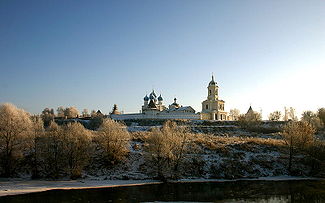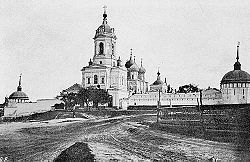
Vysotsky Monastery
Encyclopedia

Nara River
Nara River is a river in the Moscow Oblast and Kaluga Oblast in Russia. It is a left tributary of the Oka River. The length of the river is 158 kilometres. The area of its basin is 2030 km². The Nara River freezes up in November-December and stays under the ice until April. The cities of...
in Serpukhov
Serpukhov
Serpukhov is a city in Moscow Oblast, Russia, which is situated at the confluence of the Oka and the Nara Rivers. It is located south from Moscow on the Moscow—Simferopol highway. The Moscow—Tula railway passes through the town. Population: -History:...
, close to its confluence with the Oka
Oka River
Oka is a river in central Russia, the largest right tributary of the Volga. It flows through the regions of Oryol, Tula, Kaluga, Moscow, Ryazan, Vladimir, and Nizhny Novgorod and is navigable over a large part of its total length, as far upstream as to the town of Kaluga. Its length exceeds...
. Its name stems from the Russian word for "heights".
The monastery was founded in the 1370s by Vladimir the Bold
Vladimir the Bold
Vladimir Andreyevich the Bold was the most famous prince of Serpukhov. His moniker alludes to his many military exploits committed in the wars waged by his cousin, Dmitri Donskoi of Moscow....
and long served as a border fortress defending the southern approaches to Moscow
Moscow
Moscow is the capital, the most populous city, and the most populous federal subject of Russia. The city is a major political, economic, cultural, scientific, religious, financial, educational, and transportation centre of Russia and the continent...
from the Tatars
Tatars
Tatars are a Turkic speaking ethnic group , numbering roughly 7 million.The majority of Tatars live in the Russian Federation, with a population of around 5.5 million, about 2 million of which in the republic of Tatarstan.Significant minority populations are found in Uzbekistan, Kazakhstan,...
. The first hegumen
Hegumen
Hegumen, hegumenos, igumen, or ihumen is the title for the head of a monastery of the Eastern Orthodox Church or Eastern Catholic Churches, similar to the one of abbot. The head of a convent of nuns is called hegumenia or ihumenia . The term means "the one who is in charge", "the leader" in...
, Afanasy the Elder, was a disciple of St. Sergius of Radonezh
Sergius of Radonezh
Venerable Sergius of Radonezh , also transliterated as Sergey Radonezhsky or Serge of Radonezh, was a spiritual leader and monastic reformer of medieval Russia. Together with Venerable Seraphim of Sarov, he is one of the Russian Orthodox Church's most highly venerated saints.-Early life:The date of...
, whose successor, St. Nikon of Radonezh, is believed to have been tonsured a monk in this monastery.
After the Russo–Crimean War (1571), which saw the monastery reduced to ashes, it was restored on a grander scale. The five-domed Cathedral of the Conception dates from that building campaign, financed by Ivan the Terrible. The cathedral was almost certainly preceded by a medieval limestone church of which little is known.
In the mid-17th century the monastery was fortified with stone walls and four corner towers. It rivalled the Vladychny Monastery as the most important shrine of Serpukhov and welcomed rich patrons wishing to be buried within the monastery walls. Among those buried there are Gavrila Golovkin, the Chancellor of Peter the Great, and Fyodor Soimonov, the Governor of Siberia
Siberia
Siberia is an extensive region constituting almost all of Northern Asia. Comprising the central and eastern portion of the Russian Federation, it was part of the Soviet Union from its beginning, as its predecessor states, the Tsardom of Russia and the Russian Empire, conquered it during the 16th...
. The Neoclassical
Neoclassical architecture
Neoclassical architecture was an architectural style produced by the neoclassical movement that began in the mid-18th century, manifested both in its details as a reaction against the Rococo style of naturalistic ornament, and in its architectural formulas as an outgrowth of some classicizing...
belfry was completed in the 1840s.

Roman Klein
Roman Ivanovich Klein , born Robert Julius Klein, was a Russian architect and educator, best known for his Neoclassical Pushkin Museum in Moscow. Klein, an eclectic, was one of the most prolific architects of his period, second only to Fyodor Schechtel...
in a fashionable Neo-Byzantine style
Neo-Byzantine architecture
The Byzantine Revival was an architectural revival movement, most frequently seen in religious, institutional and public buildings. It emerged in 1840s in Western Europe and peaked in the last quarter of 19th century in the Russian Empire; an isolated Neo-Byzantine school was active in Yugoslavia...
. The church was destroyed after the Russian Revolution, when the monastery was given over to the Latvian Riflemen
Latvian Riflemen
This article is about Latvian military formations in World War I and Russian Civil War. For Red Army military formations in World War II see Latvian Riflemen Soviet Divisions....
to be used as barracks
Barracks
Barracks are specialised buildings for permanent military accommodation; the word may apply to separate housing blocks or to complete complexes. Their main object is to separate soldiers from the civilian population and reinforce discipline, training and esprit de corps. They were sometimes called...
. By the end of the Soviet period the monastery had lost most of its walls and was very dilapidated.
Restoration work on one of the greatest monasteries of the Moscow region started immediately after its return to the Russian Orthodox Church
Russian Orthodox Church
The Russian Orthodox Church or, alternatively, the Moscow Patriarchate The ROC is often said to be the largest of the Eastern Orthodox churches in the world; including all the autocephalous churches under its umbrella, its adherents number over 150 million worldwide—about half of the 300 million...
in 1991. Repairs were made in the Church of the Nativity of the Theotokos, dating from the 17th century and containing an icon screen
Iconostasis
In Eastern Christianity an iconostasis is a wall of icons and religious paintings, separating the nave from the sanctuary in a church. Iconostasis also refers to a portable icon stand that can be placed anywhere within a church...
and royal doors
Royal Doors
The royal doors, holy doors, or beautiful gates are the central doors of the iconostasis in an Eastern Orthodox or Greek-Catholic Church....
from the 16th century. Reconstruction of the missing sections of the wall is in prospect.
The modern monastery derives its prosperity from the venerated copy of the icon of the Inexhaustible Chalice
Inexhaustible Chalice
Inexhaustible Chalice is a Russian Marian icon which belongs to the Orans type and is considered miracle-making. The feast day for this icon is observed on May 5....
, which attracts hundreds of pilgrims from all over Russia and abroad. The icon is said to be particularly effective in the treatment of alcoholism
Alcoholism
Alcoholism is a broad term for problems with alcohol, and is generally used to mean compulsive and uncontrolled consumption of alcoholic beverages, usually to the detriment of the drinker's health, personal relationships, and social standing...
.

